Barbell exercises are the substance of the best strength training programs because they help you gain muscle and strength faster than anything else.
They simplify your training, too. The humble barbell can replace almost all the tools and toys you see people faffing with in the gym.
With just a handful of compound barbell exercises, you can train every muscle group in your body, top to toe.
In this article, you’ll learn the best barbell exercises for your chest, back, shoulders, legs, glutes, arms, and abs.
The 23 Best Barbell Exercises for Building Mass and Strength
This list of barbell exercises is far from exhaustive, but it includes all of the best barbell exercises you can do for your entire body.
The Best Barbell Chest Exercises
1. Barbell Bench Press
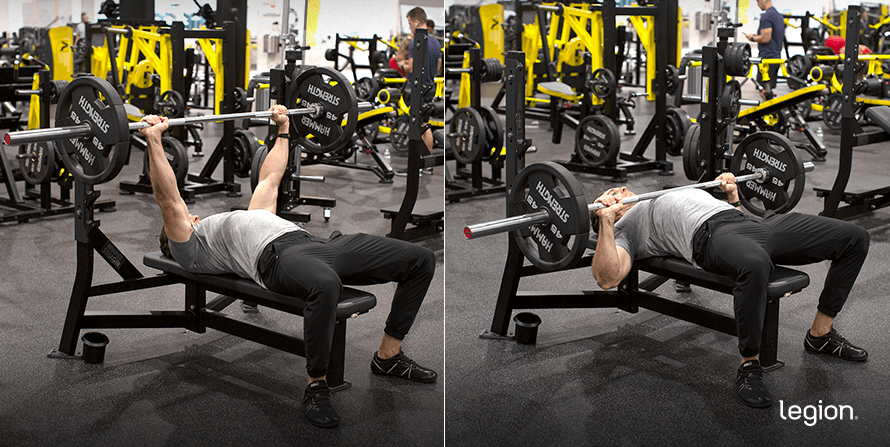
The barbell bench press is one of the single best upper-body barbell exercises because it trains every major muscle group above your waist, particularly your pecs, triceps, and deltoids. If you want to add mass to your upper body, the barbell bench press should be part of your barbell workout routine.
How to:
- Lie on a flat bench and place your feet flat on the floor.
- Pull your shoulder blades together and down, and without lifting your butt or shoulders off the bench, slightly arch your back.
- Grab the bar with a slightly wider than shoulder-width grip and unrack the barbell.
- Lower the barbell to your chest, keeping your elbows tucked 6-to-8 inches from your sides.
- Press the bar back to the starting position.
2. Incline Barbell Bench Press
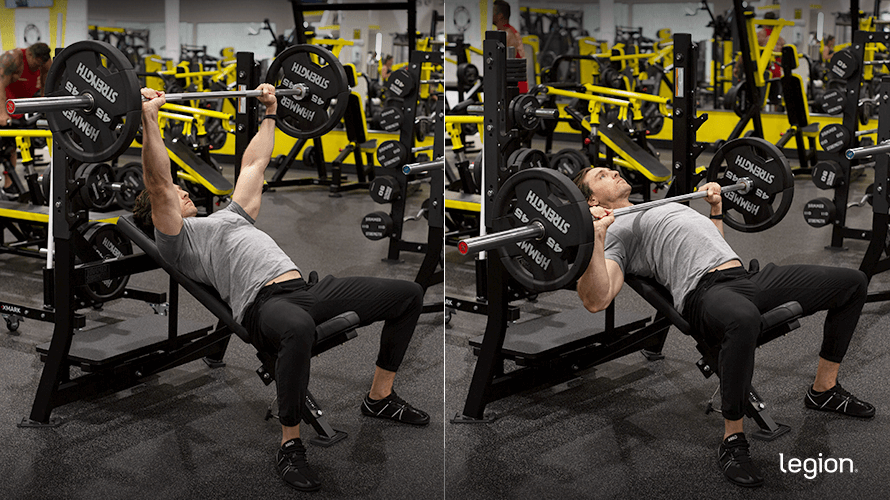
The incline barbell bench press is a highly effective barbell exercise for your chest because it emphasizes the “upper pecs,” which is key for well-rounded development. That’s why all the best barbell chest workouts include the incline barbell bench press.
How to:
- Lie on a bench angled at 30-to-45 degrees and plant your feet on the floor.
- Pull your shoulder blades together and down, and without lifting your butt or shoulders off the bench, slightly arch your back.
- Grab the bar with a slightly wider than shoulder-width grip and unrack the barbell.
- Lower the barbell to your upper chest, keeping your elbows tucked 6-to-8 inches from your sides.
- Press the bar back to the starting position.
3. Close-Grip Barbell Bench Press
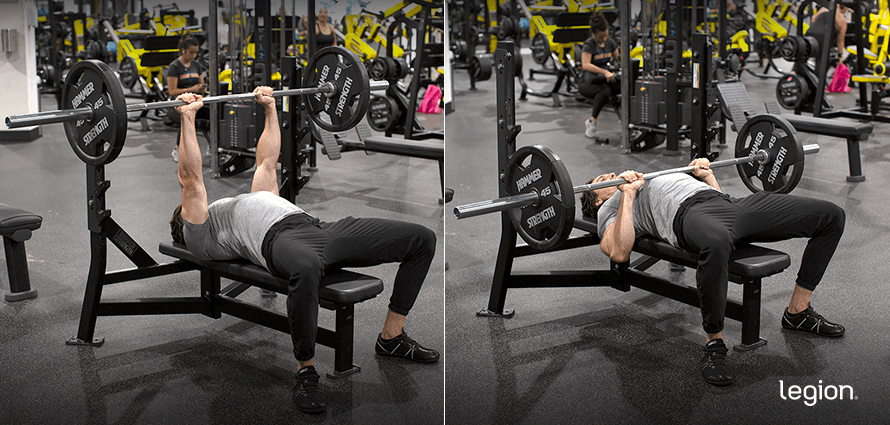
The close-grip bench press is another barbell chest exercise that emphasizes your upper pecs. It also trains your triceps to a high degree, making it an excellent barbell exercise for developing all your “pushing” muscles.
How to:
- Lie on a flat bench, pull your shoulder blades together and down, and without lifting your butt or shoulders off the bench, slightly arch your back.
- Grab the bar with a shoulder-width grip or slightly narrower, and unrack the barbell so it’s directly above your chest.
- Bring the barbell to your lower chest while keeping your elbows tucked at about a 30-degree angle relative to your torso.
- When the bar touches your chest, explosively press the bar back to the starting position.
The Best Barbell Back Exercises
1. Deadlift
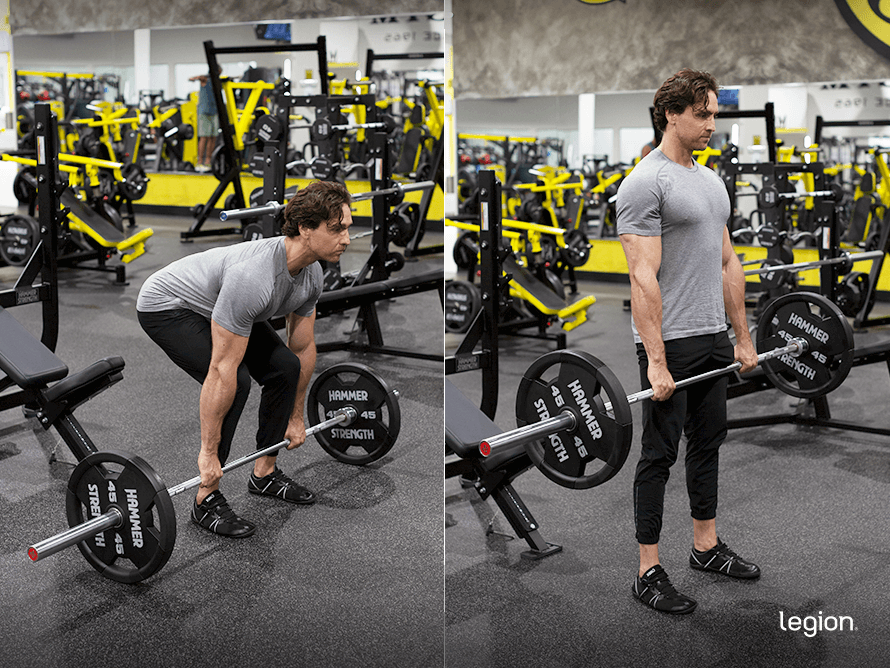
The deadlift trains every muscle in on the back side of your body, though it’s a particularly good lower back exercise. It also allows you to use some of the heaviest weights in any of your workouts, which means it’s an ideal addition to a barbell workout for gaining strength and muscle.
How to:
- Position your feet slightly narrower than shoulder-width apart with your toes pointed slightly out.
- Move a loaded barbell over your midfoot so it’s about an inch from your shins.
- Take a deep breath into your belly, then place your hands on the bar just outside your shins with your palms facing you.
- Flatten your back and drive your body upward and slightly back by pushing through your heels until you’re standing upright.
- Reverse the movement and return to the starting position.
2. Barbell Row
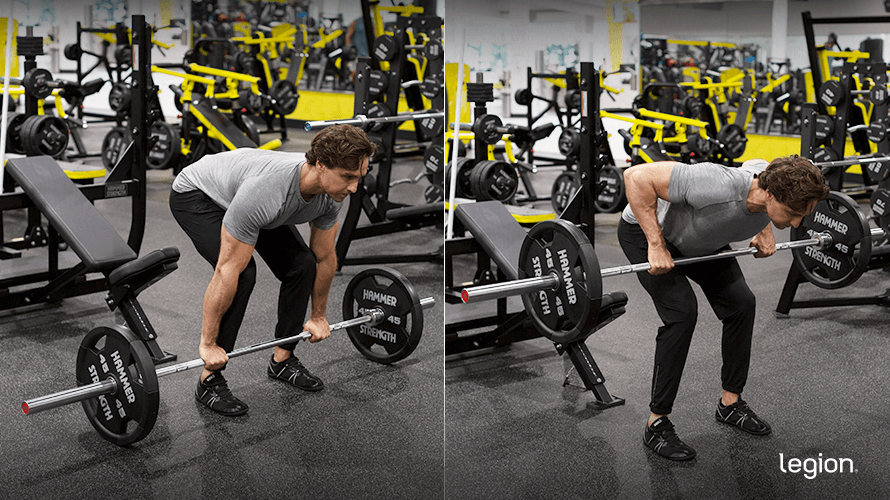
The barbell bent-over row is a staple in all great barbell workouts because it allows you to lift more weight than most other back exercises. This is significant because exercises that enable you to lift heavy weights are typically better for gaining mass and strength.
How to:
- Position your feet under a loaded barbell about shoulder-width apart with your toes pointed slightly outward.
- Bend over and grab the bar with a slightly wider than shoulder-width grip and your palms facing you.
- Straighten your back and raise your hips until your back is roughly parallel to the floor.
- Initiate the movement by driving through your legs. Then, using the momentum generated by your lower body, pull the barbell to your upper body, touching it anywhere between your lower chest and belly button.
- Once the bar touches your body, reverse the movement and return to the starting position.
3. Pendlay Row
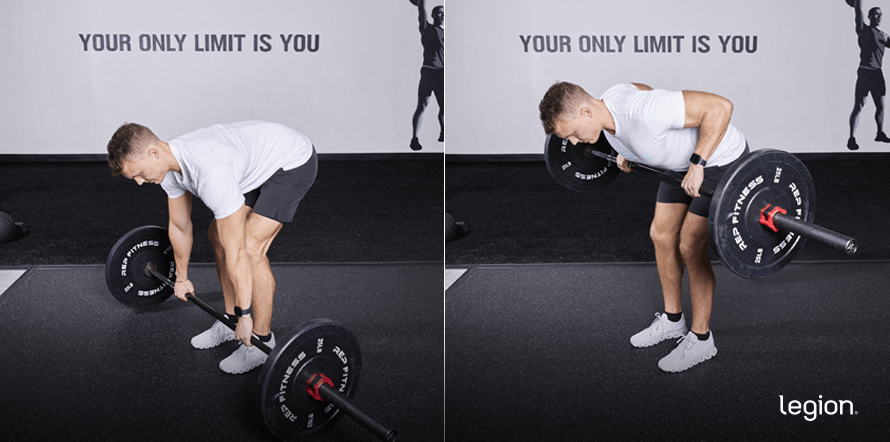
The Pendlay row is a similar compound barbell back exercise to the barbell row, except you don’t use your lower body to help hoist the bar off the floor. As such, you usually can’t lift as much weight as you do with other row variations, but it also means your lats, traps, and rhomboids do more of the work.
How to:
- Position your feet under a loaded barbell about shoulder-width apart, with your toes pointed slightly outward.
- Bend over and grab the bar with a slightly wider than shoulder-width grip with your palms facing toward you.
- Straighten your back and raise your hips until your back is roughly parallel to the floor.
- Pull the barbell to your torso, between your lower chest and navel.
- Reverse the movement and return the bar to the floor.
The Best Barbell Shoulder Exercises
1. Standing Barbell Overhead Press
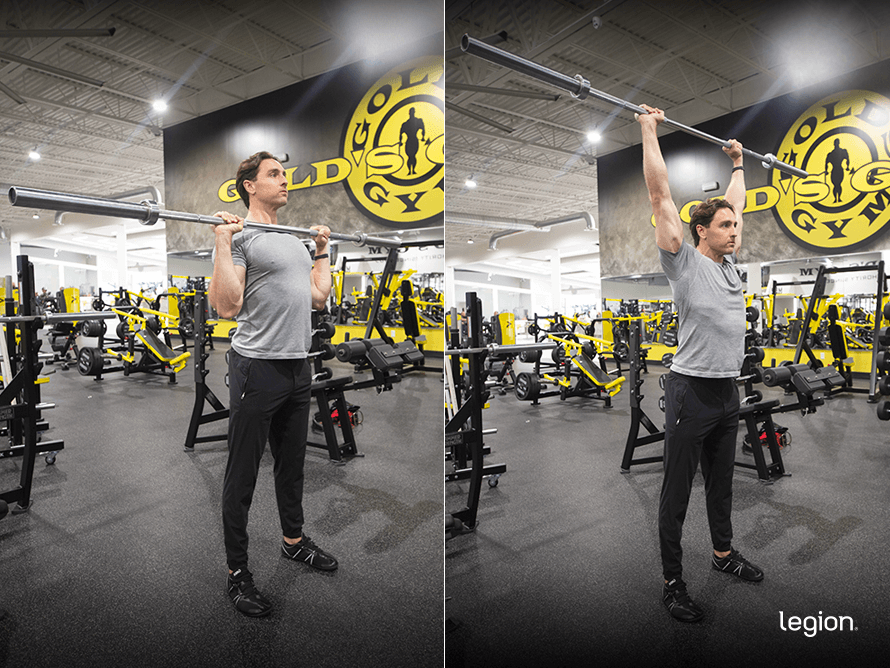
The standing overhead press is one of the most comprehensive barbell lifts on this list: it improves upper-body strength, builds chest, shoulder, and tricep size, and enhances whole-body balance and coordination.
How to:
- Set a barbell in a rack at the same height as your upper chest.
- Grip the bar with a shoulder-width grip and your palms facing away from you.
- Unrack the barbell, step backward, and plant your feet just outside of shoulder width.
- Push the bar toward the ceiling until your arms are straight.
- Reverse the movement and return to the starting position.
2. Seated Barbell Overhead Press
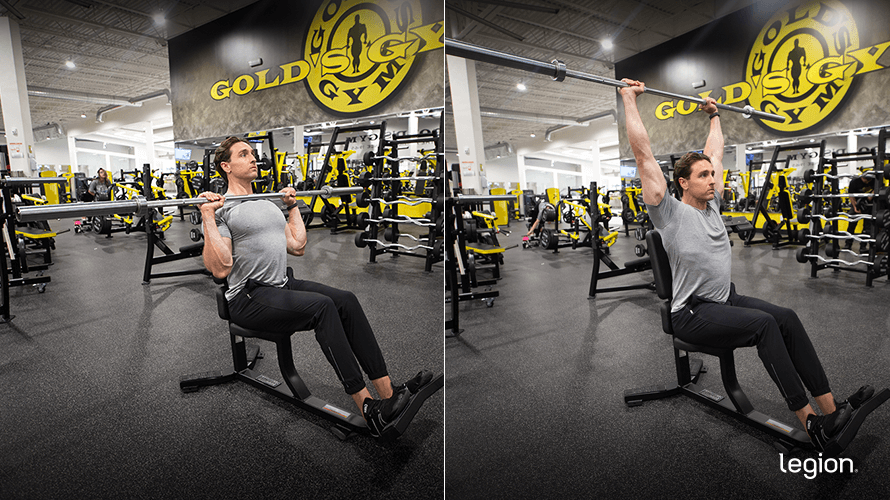
The seated barbell overhead press and the standing barbell overhead press are similar shoulder exercises. However, because the seated barbell overhead press doesn’t require as much full-body coordination, you can lift heavier weights and progress faster, which helps you build shoulder mass.
How to:
- Set up an upright bench in a squat rack or use a seated barbell overhead press station.
- Set a barbell in the rack at about shoulder height when standing.
- Sit down and grip the bar with a shoulder-width grip and your palms facing away from you.
- Unrack the barbell and lower it to your collarbone.
- Press the bar toward the ceiling and return to the starting position.
3. Barbell Upright Row
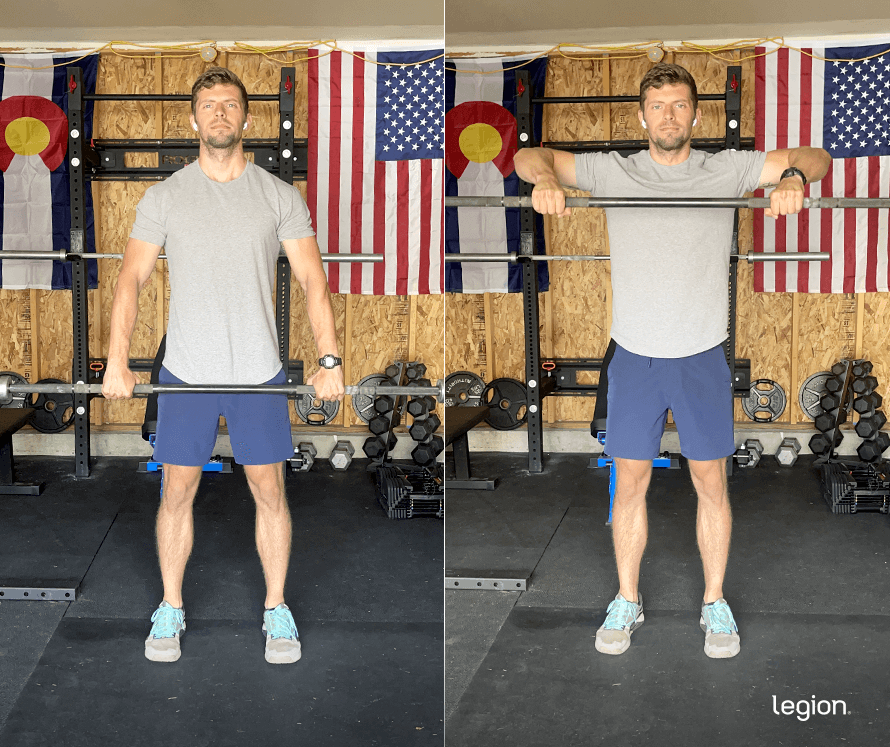
The upright row emphasizes the side delts, so it’s a fantastic barbell shoulder exercise for developing broad, proportional shoulders.
How to:
- Stand up straight and hold a barbell in front of your thighs with your palms facing you.
- Lift the bar straight upward until your upper arms are parallel with the floor, keeping your elbows higher than your forearms throughout the movement.
- Reverse the movement and return to the starting position.
4. Barbell Rear Delt Row
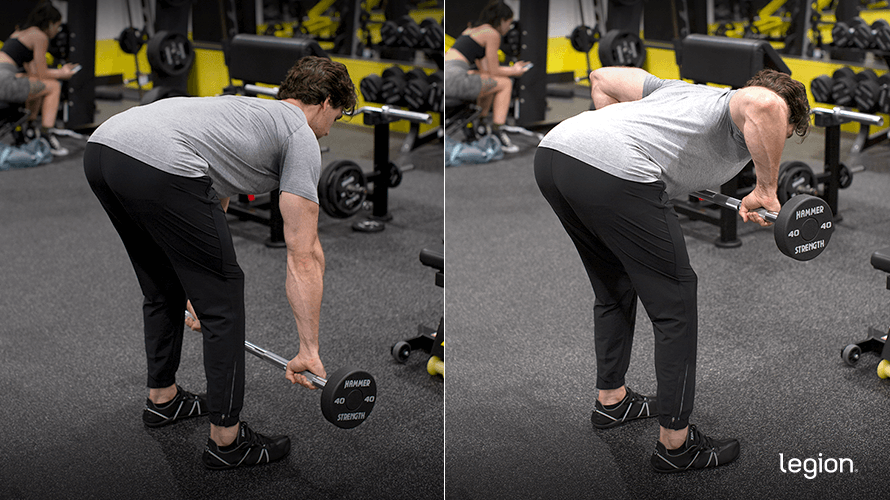
The barbell rear delt row isolates the rear delts, which many weightlifters neglect. Training these muscles is crucial for developing well-rounded and strong shoulders.
How to:
- Position your feet about shoulder-width apart with your toes pointed slightly outward.
- Grab a barbell with a slightly wider than shoulder-width grip and your palms facing you.
- Flatten your back so it’s roughly parallel to the floor, and let your arms hang straight down.
- Pull the barbell to your mid-chest, flaring your elbows at about a 60-degree angle relative to your body. As you lift the weight, squeeze your shoulder blades together.
- Reverse the movement and return to the starting position.
The Best Barbell Leg Exercises
1. Barbell Back Squat
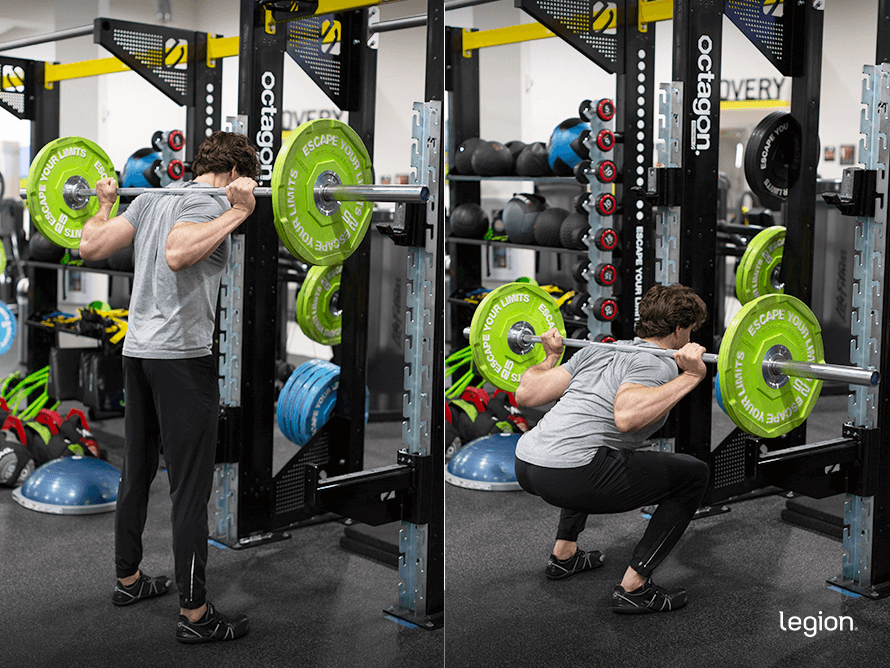
The barbell back squat is hands down the most effective barbell quad exercise you can do for building size and strength. It also allows you to use heavy weights, which maximizes tension in your muscle fibers and, thus, muscle growth.
How to:
- Position a barbell in a squat rack at about the height of your nipples.
- Step under the bar, pinch your shoulder blades together, and rest the bar directly above the bony ridges on the bottom of your shoulder blades.
- Lift the bar out of the rack, take one or two steps backward, and place your feet a little wider than shoulder-width apart with your toes pointing slightly outward.
- Sit down and remember to keep your back straight and push your knees out in the same direction as your toes throughout each rep.
- Stand up and return to the starting position.
2. Barbell Front Squat
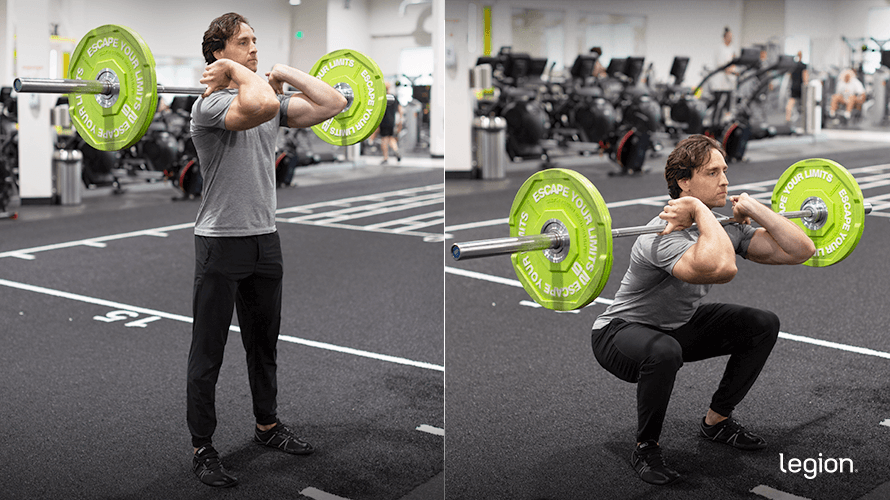
The barbell front squat is a fantastic leg exercise with a barbell. It’s also gentler on your knees and back than the back squat, making it more suitable for those with knee or back issues.
How to:
- Position a barbell in a squat rack at the height of your breastbone.
- Grab the bar with a shoulder-width grip and your palms facing away from you.
- Step closer to the bar so that it presses against the top of your breastbone, and push your elbows up and out in front of it.
- Rest the bar on the front of your shoulders and hold it in place with your hands
- Lift the bar out of the rack, step backward, and place your feet a little wider than shoulder-width apart with your toes pointing slightly outward.
- While keeping your back straight and elbows up, sit down, pushing your knees in the same direction as your toes.
- Stand up and return to the starting position.
3. Barbell Lunge
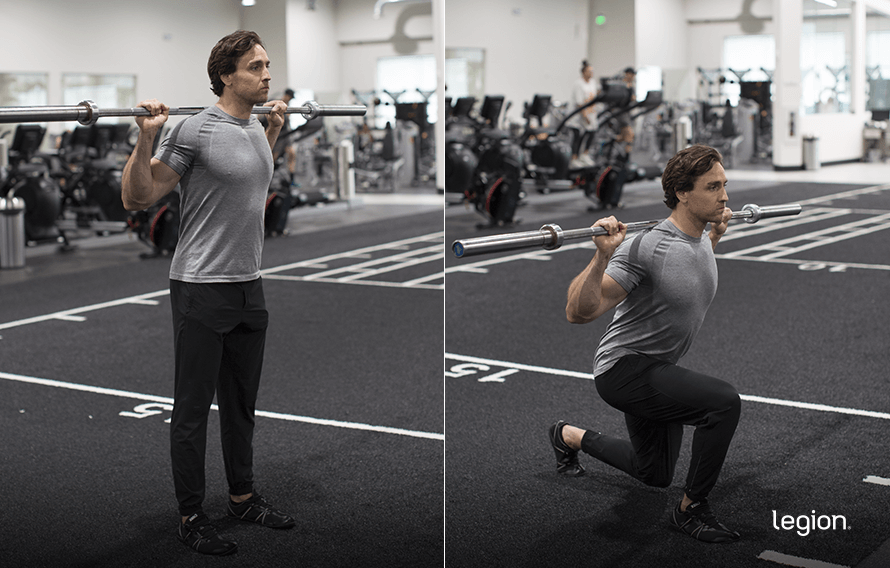
Unlike most barbell leg exercises, the barbell lunge trains each side of your body independently. This helps you find and fix muscle imbalances so you develop symmetrical mass and strength.
How to:
- Position a barbell across your mid traps and rear delts and your feet hip-width apart.
- Take a long step forward with your right foot—about 2-to-3 feet. With most of your weight on your front leg, kneel down until your left knee touches the floor.
- Reverse the motion by pushing off the floor with your front foot and leaning slightly backward, allowing your legs to straighten.
- Once you’re standing, bring your right foot back to the starting position.
The Best Barbell Glute and Hamstring Exercises
1. Romanian Deadlift
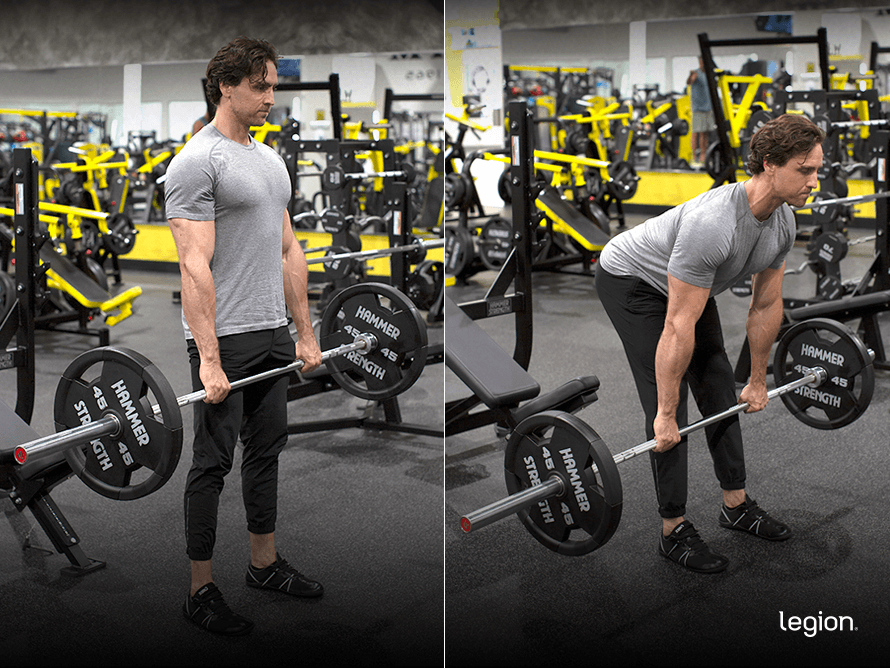
The Romanian deadlift is a fantastic barbell hamstring exercise that also trains your glutes. It’s so effective because it allows you to lift heavy weights and train your muscles while stretched, making it ideal for gaining muscle and strength.
(Fun fact: During a set of “RDLs,” your upper back has to work hard to prevent your shoulders from rounding. This makes the RDL one of the best barbell trap exercises you can do, too.)
How to:
- Stand up straight holding a barbell with a shoulder-width overhand grip (palms facing your body).
- Flatten your back and lower the weights toward the floor in a straight line while keeping your legs mostly straight, allowing your butt to move backward as you descend.
- Once you feel a stretch in your hamstrings, bend your knees slightly more and continue lowering the weights until your lower back begins to round.
- Reverse the movement and return to the starting position.
2. Barbell Hip Thrust
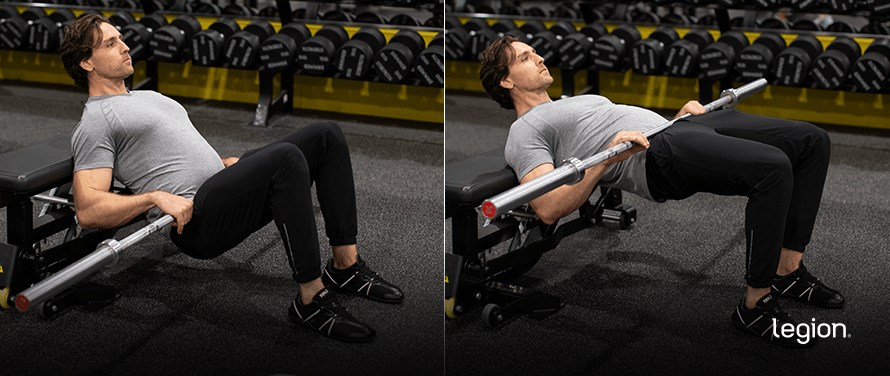
The hip thrust is another excellent barbell glute exercise that forces your glutes and hamstrings to work hard throughout the entire range of motion. This unique benefit makes the hip thrust an excellent booty builder.
How to:
- Sit on the ground with your shoulders resting against a bench that’s perpendicular to your body.
- Roll a barbell over your thighs so it sits in your hip crease.
- Plant your feet on the floor about shoulder-width apart and 12-to-18 inches from your butt so your knees are bent to about 90 degrees.
- Push your hips upward by pressing through your heels until your upper body and thighs are parallel to the ground and your shins are vertical.
- Reverse the movement and return to the starting position.
3. Barbell Good Morning
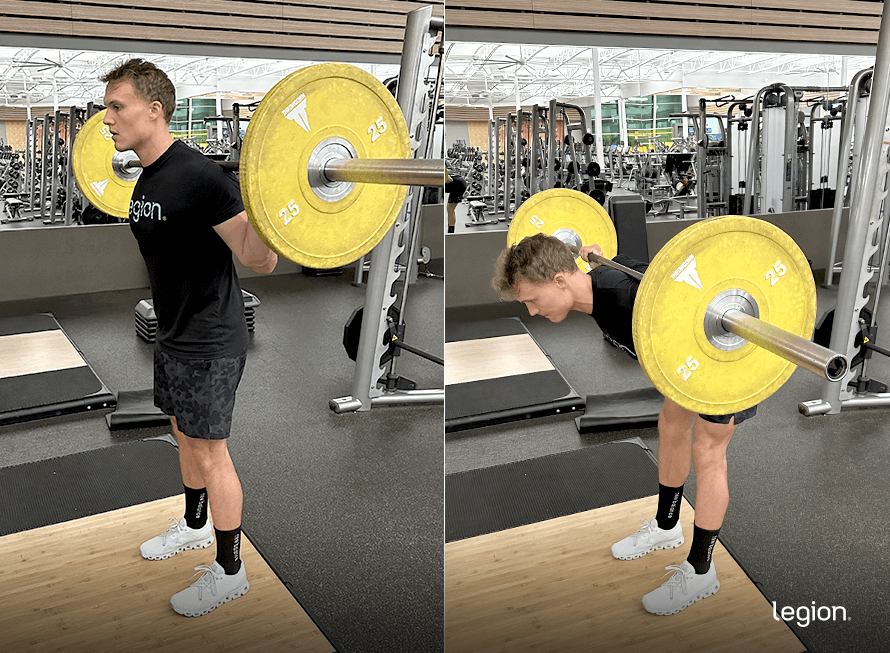
The good morning is another solid barbell glute exercise that also trains your hamstrings and lower back. It’s effective because it allows you to train your hamstrings and glutes with heavy weights while stretched, which benefits muscle growth.
How to:
- Position a barbell across your mid traps and rear delts and your feet about shoulder-width apart.
- With slightly bent knees, hinge at the hips and move your butt backward to lower the bar in a straight line toward the ground.
- Once you can’t lower the bar any further without bending your back, reverse the movement and return to the starting position.
The Best Barbell Arm Exercises
1. Barbell Curl

The barbell curl is a top-tier barbell bicep exercise because it allows you to train your biceps through a full range of motion and use maximally heavy weights, which is beneficial for gaining strength and muscle. That’s why all good barbell arm workouts revolve around the barbell curl.
How to:
- Stand tall holding a barbell with your palms shoulder-width apart and facing away from you.
- Your arms should be straight, and the bar should be resting against your thighs.
- Bring the bar to shoulder height by bending at the elbow.
- Lower the bar to the starting position.
2. Barbell Preacher Curl
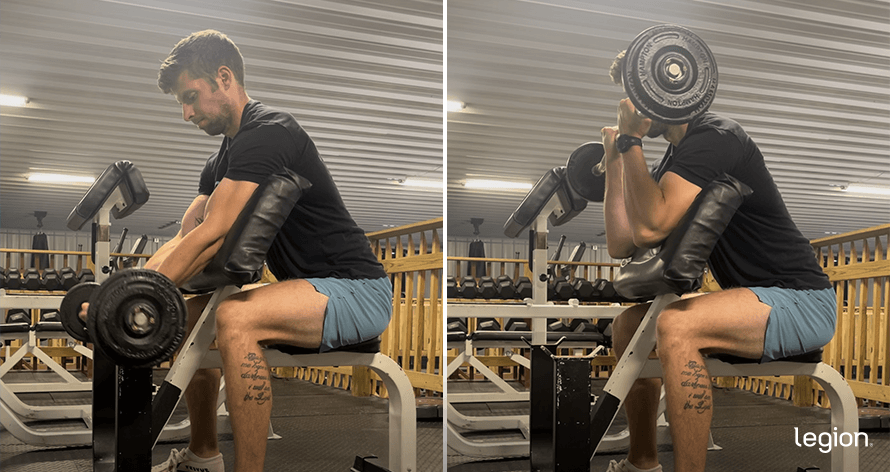
The preacher curl is unique among barbell exercises for arms because it involves a preacher curl bench. This piece of equipment prevents you from using momentum, so your biceps do most of the work. It also helps you target your biceps short head, which is crucial for developing thick biceps.
- Adjust a preacher curl station so that the top of the pad sits in your armpits while you’re sitting on the seat.
- Grab the bar with a shoulder-width grip and your palms facing up.
- Curl the weight to shoulder height, making sure to keep your elbows on the pad.
- Lower the bar and return to the starting position.
3. Barbell JM Press
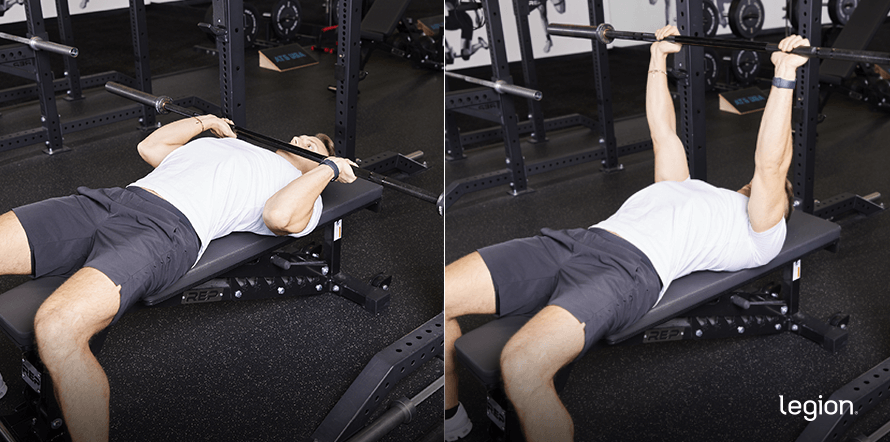
The JM press trains your triceps through a full range of motion and allows you to train with heavy loads. This makes it a must-include triceps exercise in any barbell workout for mass.
- Lie on a flat bench, pull your shoulder blades together and down, and without lifting your butt or shoulders off the bench, slightly arch your back.
- Grip the barbell with a slightly narrower than shoulder-width grip, and unrack it so it’s directly above your chest.
- Lower the barbell toward your neck. As you do so, keep your elbows up and in front of your torso, and slightly bend your wrists backward so that your palms face the ceiling.
- When your forearms and biceps touch, press the bar to the starting position.
4. Skullcrusher
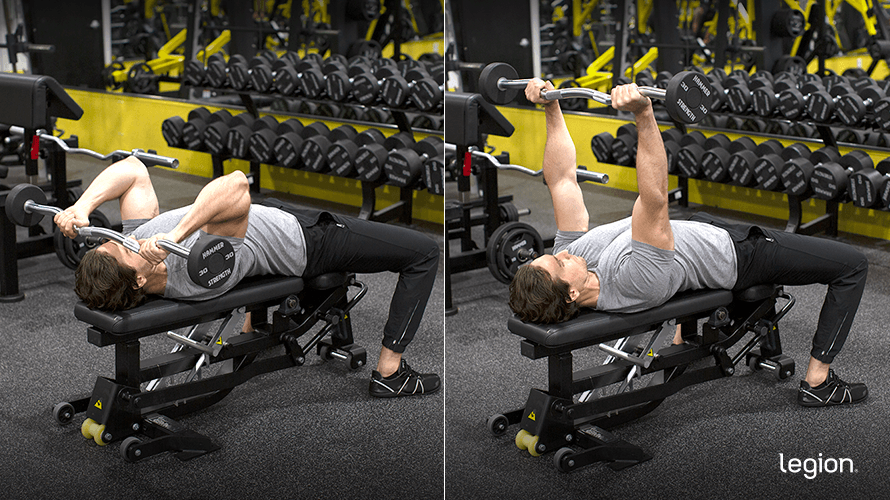
The skullcrusher is a great barbell triceps exercise because it trains the slightly smaller medial and lateral heads of the triceps, ensuring you have defined, proportional upper arms.
How to:
- While lying on a flat bench, hold a barbell above your chest with a shoulder-width grip.
- Bend your elbows and lower the bar until it’s above your forehead.
- Reverse the movement and return to the starting position.
The Best Barbell Ab Exercises
1. Barbell Landmine Rainbow
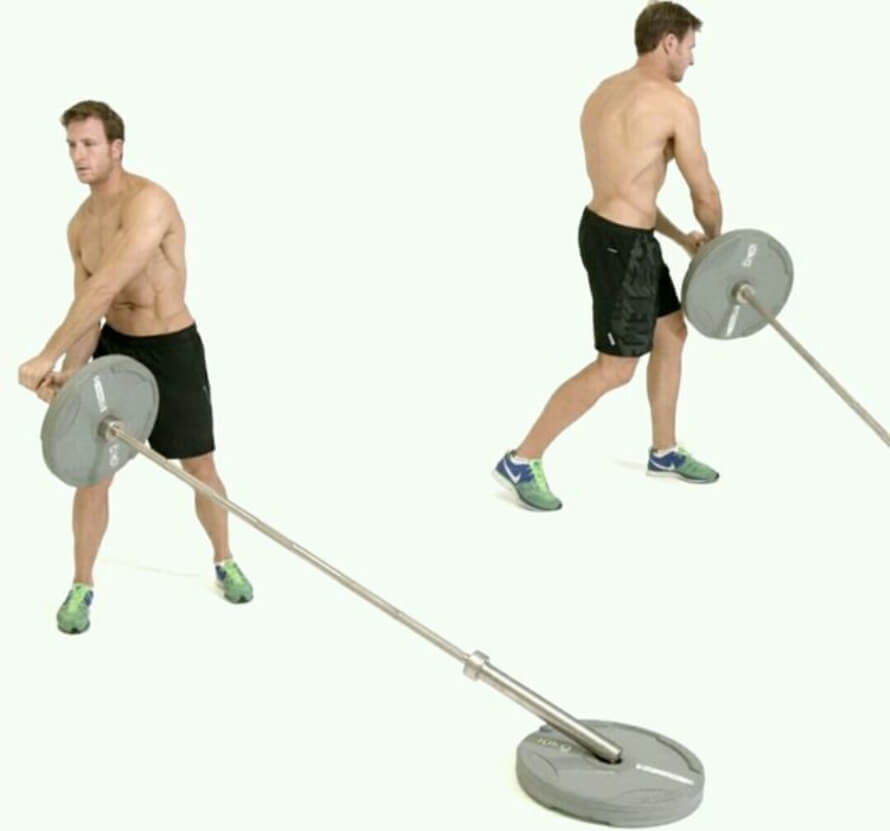
The “rainbow” is a great barbell landmine exercise because it forces you to stabilize your core muscles under load. This builds the core strength and stability you need if you play sports that require you to twist and turn at speed.
How to:
- Place one end of an empty barbell in a landmine attachment or wedge it into the corner of the room and load the other end with weight plates.
- While facing the weighted end of the barbell, hoist the barbell to chest height.
- Press the bar overhead, then keeping your arms straight, lower the bar down toward your left hip, pivoting your right foot inward as you lower the bar.
- Using your core, drive the bar in an arch until it’s back overhead, then lower it down toward your right hip, pivoting your left foot inward as you lower the bar.
- Continue to alternate from side to side for the desired number of reps.
2. Barbell Rollout
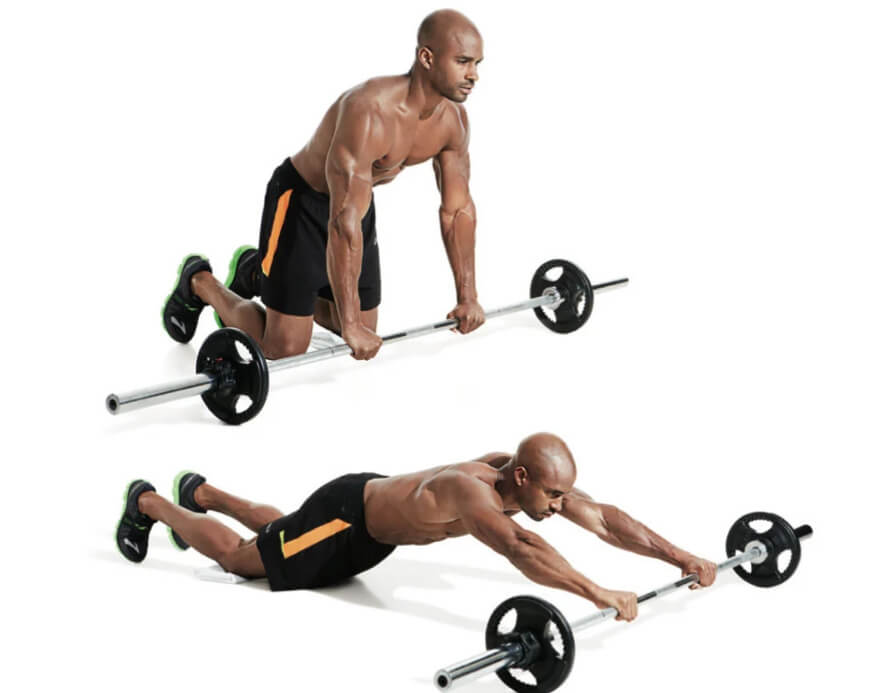
Studies show that the barbell rollout is an extremely effective barbell core exercise. It emphasizes the rectus abdominis (six-pack muscles) and obliques, helping you build a strong, stable, and defined midsection.
How to:
- Kneel on the floor with a loaded barbell in front of you.
- With your arms fully extended, grab the barbell and slowly roll it away from you.
- Brace your core so your torso remains rigid and your lower back flat.
- Roll the barbell until your body is as close to parallel with the floor as possible.
- Reverse the movement and return to the starting position by flexing your abs.
3. Barbell Sit-up
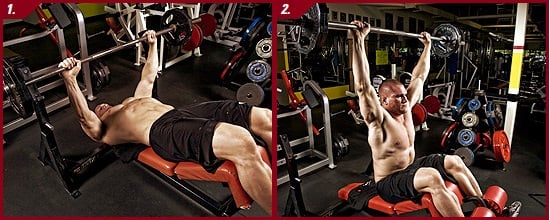
No barbell workout for abs is complete without the barbell sit-up. It’s so effective because it allows you to easily apply progressive overload, which is vital for developing ab strength and definition.
How to:
- Lie on a sit-up bench with your feet wedged under the foot pads.
- Hold a barbell directly above your chest with your arms straight.
- Keeping your arms perpendicular to the floor and your back flat, use your abs to lift your chest toward the ceiling until your lower back comes off the bench.
- Reverse the movement and return to the starting position.
Benefits of Barbell Exercises
They’re ideal for gaining strength.
Barbell exercises are ideal for building strength for several reasons:
- Training with heavy weights is crucial for gaining strength. Unlike dumbbells, which typically top out at around 100 pounds, barbells can support thousands of pounds of weight. This means you can continue progressing with barbell training much longer than with dumbbells.
- Because you use both hands to stabilize one bar, the weight is distributed evenly across your body. This makes it easier to lift heavier loads compared to trying to balance heavy dumbbells in each hand.
- Barbells are generally safer when lifting heavy weights. When dumbbells get too heavy, they can become awkward and risky, especially for lifts like the bench press, shoulder press, or squat, where you must “clean” the weights to shoulder height before you can begin your set. Barbell exercises often also involve a rack. This allows you to get into a safe and stable position before bearing any weight, which makes it less likely that you’ll hurt yourself setting up.
They’re adaptable.
You can use barbells for many different types of training, including:
So, no matter how you like to train, you can almost always use a barbell.
They allow you to increase weight in small increments.
Progressively lifting heavier weights over time is paramount for muscle and strength gain.
Barbell exercises simplify this process because you can increase the weight you lift in small increments. For example, adding two 2.5-pound plates increases the total weight by just 5 pounds.
In contrast, dumbbells usually jump up in 5-pound increments, which means you have to add 10 pounds total whenever you progress on a dumbbell exercise.
While this can be manageable when you’re new to weightlifting, these larger jumps can become too challenging as you get more experienced, which increases the odds of becoming plateaued or injured.
+ Scientific References
- Barnett, Chris , et al. Effects of Variations of the Bench Press Exercise on the EMG Activity of Five Shoulder Muscles. Nov. 1995, www.researchgate.net/publication/232217991_Effects_of_Variations_of_the_Bench_Press_Exercise_on_the_EMG_Activity_of_Five_Shoulder_Muscles, http://dx.doi.org/10.1519/00124278-199511000-00003.
- Neto, Walter Krause , et al. Gluteus Maximus Activation during Common Strength and Hypertrophy Exercises: A Systematic Review. Mar. 2020, pp. 19(1):195-203, www.researchgate.net/publication/339302672_Gluteus_Maximus_Activation_during_Common_Strength_and_Hypertrophy_Exercises_A_Systematic_Review.
- Gullett, Jonathan C, et al. “A Biomechanical Comparison of Back and Front Squats in Healthy Trained Individuals.” Journal of Strength and Conditioning Research, vol. 23, no. 1, Jan. 2009, pp. 284–292, journals.lww.com/nsca-jscr/fulltext/2009/01000/A_Biomechanical_Comparison_of_Back_and_Front.41.aspx, https://doi.org/10.1519/jsc.0b013e31818546bb.
- Contreras, Bret, et al. “Barbell Hip Thrust.” Strength and Conditioning Journal, vol. 33, no. 5, Oct. 2011, pp. 58–61, https://doi.org/10.1519/ssc.0b013e31822fa09d.
- Kassiano, Witalo, et al. Addition of the Barbell Hip Thrust Is Effective for Enhancing Gluteus Maximus Hypertrophy in Young Women. 2 May 2023, https://doi.org/10.21203/rs.3.rs-2882506/v1. Accessed 13 May 2023.
- Schellenberg, Florian, et al. “Towards Evidence Based Strength Training: A Comparison of Muscle Forces during Deadlifts, Goodmornings and Split Squats.” BMC Sports Science, Medicine and Rehabilitation, vol. 9, no. 1, 17 July 2017, https://doi.org/10.1186/s13102-017-0077-x.
- Ebben, William P. “Hamstring Activation during Lower Body Resistance Training Exercises.” International Journal of Sports Physiology and Performance, vol. 4, no. 1, Mar. 2009, pp. 84–96, https://doi.org/10.1123/ijspp.4.1.84.
- Youdas, James W, et al. “An Electromyographic Analysis of the Ab-Slide Exercise, Abdominal Crunch, Supine Double Leg Thrust, and Side Bridge in Healthy Young Adults: Implications for Rehabilitation Professionals.” Journal of Strength and Conditioning Research, vol. 22, no. 6, Nov. 2008, pp. 1939–1946, https://doi.org/10.1519/jsc.0b013e31818745bf.
- Moraes, Antonio C., et al. “EMG Activation of Abdominal Muscles in the Crunch Exercise Performed with Different External Loads.” Physical Therapy in Sport: Official Journal of the Association of Chartered Physiotherapists in Sports Medicine, vol. 10, no. 2, 1 May 2009, pp. 57–62, pubmed.ncbi.nlm.nih.gov/19376473/, https://doi.org/10.1016/j.ptsp.2009.01.001.
- Schoenfeld, Brad J., et al. “Effects of Low- vs. High-Load Resistance Training on Muscle Strength and Hypertrophy in Well-Trained Men.” Journal of Strength and Conditioning Research, vol. 29, no. 10, Oct. 2015, pp. 2954–2963, pubmed.ncbi.nlm.nih.gov/25853914/, https://doi.org/10.1519/jsc.0000000000000958.
- Schoenfeld, Brad J., et al. “Strength and Hypertrophy Adaptations between Low- vs. High-Load Resistance Training.” Journal of Strength and Conditioning Research, vol. 31, no. 12, Dec. 2017, pp. 3508–3523, journals.lww.com/nsca-jscr/Fulltext/2017/12000/Strength_and_Hypertrophy_Adaptations_Between_Low_.31.aspx, https://doi.org/10.1519/jsc.0000000000002200.
- Schoenfeld, Brad J. “The Mechanisms of Muscle Hypertrophy and Their Application to Resistance Training.” Journal of Strength and Conditioning Research, vol. 24, no. 10, 2010, pp. 2857–72, https://doi.org/10.1519/JSC.0b013e3181e840f3.

